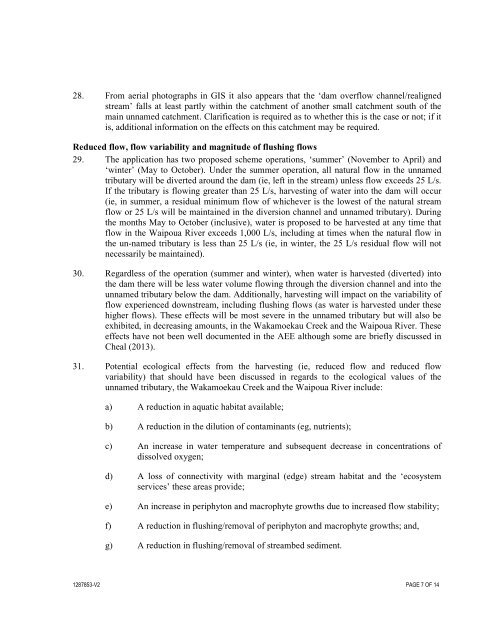Appendix 9 Aquatic Ecology Review Memorandum - Greater ...
Appendix 9 Aquatic Ecology Review Memorandum - Greater ...
Appendix 9 Aquatic Ecology Review Memorandum - Greater ...
Create successful ePaper yourself
Turn your PDF publications into a flip-book with our unique Google optimized e-Paper software.
28. From aerial photographs in GIS it also appears that the ‘dam overflow channel/realigned<br />
stream’ falls at least partly within the catchment of another small catchment south of the<br />
main unnamed catchment. Clarification is required as to whether this is the case or not; if it<br />
is, additional information on the effects on this catchment may be required.<br />
Reduced flow, flow variability and magnitude of flushing flows<br />
29. The application has two proposed scheme operations, ‘summer’ (November to April) and<br />
‘winter’ (May to October). Under the summer operation, all natural flow in the unnamed<br />
tributary will be diverted around the dam (ie, left in the stream) unless flow exceeds 25 L/s.<br />
If the tributary is flowing greater than 25 L/s, harvesting of water into the dam will occur<br />
(ie, in summer, a residual minimum flow of whichever is the lowest of the natural stream<br />
flow or 25 L/s will be maintained in the diversion channel and unnamed tributary). During<br />
the months May to October (inclusive), water is proposed to be harvested at any time that<br />
flow in the Waipoua River exceeds 1,000 L/s, including at times when the natural flow in<br />
the un-named tributary is less than 25 L/s (ie, in winter, the 25 L/s residual flow will not<br />
necessarily be maintained).<br />
30. Regardless of the operation (summer and winter), when water is harvested (diverted) into<br />
the dam there will be less water volume flowing through the diversion channel and into the<br />
unnamed tributary below the dam. Additionally, harvesting will impact on the variability of<br />
flow experienced downstream, including flushing flows (as water is harvested under these<br />
higher flows). These effects will be most severe in the unnamed tributary but will also be<br />
exhibited, in decreasing amounts, in the Wakamoekau Creek and the Waipoua River. These<br />
effects have not been well documented in the AEE although some are briefly discussed in<br />
Cheal (2013).<br />
31. Potential ecological effects from the harvesting (ie, reduced flow and reduced flow<br />
variability) that should have been discussed in regards to the ecological values of the<br />
unnamed tributary, the Wakamoekau Creek and the Waipoua River include:<br />
a) A reduction in aquatic habitat available;<br />
b) A reduction in the dilution of contaminants (eg, nutrients);<br />
c) An increase in water temperature and subsequent decrease in concentrations of<br />
dissolved oxygen;<br />
d) A loss of connectivity with marginal (edge) stream habitat and the ‘ecosystem<br />
services’ these areas provide;<br />
e) An increase in periphyton and macrophyte growths due to increased flow stability;<br />
f) A reduction in flushing/removal of periphyton and macrophyte growths; and,<br />
g) A reduction in flushing/removal of streambed sediment.<br />
1287853-V2 PAGE 7 OF 14
















